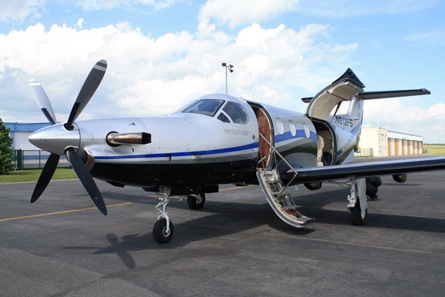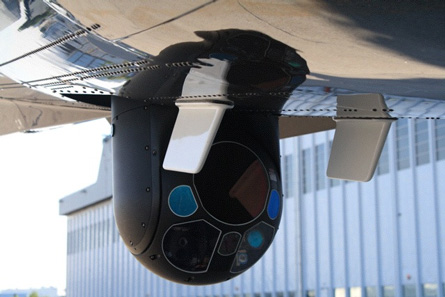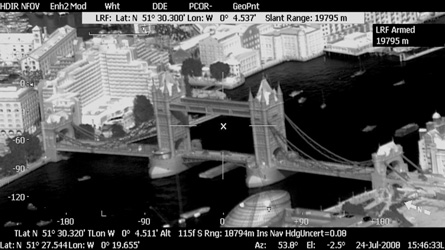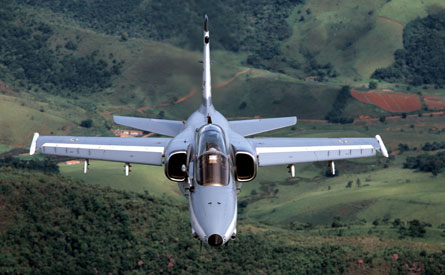Look up at about 10:00 each morning this week, and you might catch a glimpse of a gleaming new Pilatus PC-12NG taking to the air. Delivered during April, the aircraft is one of two new examples acquired by US company FLIR Systems to test and demonstrate the capabilities of its sophisticated airborne sensor payloads.
Being used to conduct customer demonstrations at Le Bourget, the Swiss-built aircraft arrived at the show after highlighting the capabilities of a new retractable electro-optical/infrared sensor package to potential buyers in Greece, Italy and Norway, and also elsewhere in France.
 |
|---|
© FLIR Systems |
The payload in question is a second-generation version of FLIR's successful Star Safire HD (high-definition) design, providing all-digital performance. First fielded around five years ago by television news channels and the film industry, digital HD technology is now starting to break through to also support military customers, says Star HD product manager Robert Kubis.
"FLIR Systems has taken the Star Safire HD's infrared camera core and added their expertise in manufacturing infrared focal-plane detectors to provide more range, performance and pixels on target," the company says. "This affords beautiful daylight colour pictures, but more importantly, equally crisp and clear images at night."
Contained within a 15in turret, the stabilised HD system offers thermal, colour and image intensified cameras, three lasers and an inertial measurement unit. "We try to fit as many payload options in as possible so we can sell to different customers, or expand the role," says Kubis.
 |
|---|
© FLIR Systems |
Each camera has five stepped fields of view, from 30° down to 0.25°, offering progressively increased magnification. Infrared images are offered on the digital version with a 1280 x 720 pixel capacity, while the colour camera also now has sharper resolution. A digital downlink can relay broadcast quality, streaming HD images to the ground, and the payload will perform 95% of its work without the need for manual adjustment.
The rapid development of the new standard reflects a company strategy which sees it reinvest around 10% of its revenue per year into research and development activities.
FLIR has already delivered or received orders for more than 250 first-generation Star Safire HD sensors since launching the product at 2005's Paris air show, and Kubis says: "For those who bought recently you can upgrade and keep the value in your investment." In all, around 3,000 Star Safire-series turrets have now been installed on over 100 aircraft types.
 |
|---|
© FLIR Systems |
FLIR's Star Safire HD product provides high-quality, long-range infrared imagery
The company's wide range of products are also used on land vehicles, naval vessels, and by ground troops, for example in sniper sights and equipment used by forward air controllers. Unattended sensors also watch desert areas in the Middle East for suspicious vehicle or personnel movements.
"We've got a very large [orders] backlog, and are seeing a continued strong interest across the product line," says David Strong, FLIR's vice president of communications. Underlining the current demand for airborne systems, FLIR's previous one PC-12 flew around 2,000 test and demonstration hours last year alone.
The company has received orders for over 60 Star Safire III/HD, Brite Star II and Talon systems this year for integration on Sikorsky UH-60 Black Hawk-series utility helicopters for USA, and for international customers including Bahrain and the United Arab Emirates. This represents approaching half of the more than 135 EO/IR turrets sold to at least 12 countries in the first half of this year for integration on helicopters, maritime patrol aircraft and unmanned air vehicles.
In a new success, the company on Monday announced the receipt of a $7 million deal to supply Embraer with NavFLIR airborne thermal imaging systems to be installed with the Brazilian air force's AMX strike aircraft (below) over the next five years.
 |
|---|
© Embraer |
To support in-service equipment, including that used by US forces in Afghanistan and Iraq, FLIR now has overseas centres in Abu Dhabi, Australia, Canada, Colombia, Dubai, Japan, Saudi Arabia and the UK. The company manufactures IR sensors in the USA and Sweden, and sources daylight colour cameras from commercial suppliers such as Hitachi and Sony.
Many of FLIR's approximately 2,000 employees are ex-military or coastguard personnel, which Strong says supports "a great work ethic. From a cultural standpoint, we try to maintain that sense of urgency, because these systems are mission critical, and they are saving lives."
The company on 30 April began using an expanded facility at its West Malling site in Kent, the UK, marking the completion of a £1 million ($1.6 million) upgrade which has provided additional working space and new equipment including optical alignment benches and test equipment. "We support the UK military and police, and also supply and support into Europe," says Andrew Phillips, FLIR's vice-president Europe and manager of the West Malling site, which first opened in 1997.
The improved facility was opened by Royal Navy Rear Adm Anthony Johnstone-Burt, commander of the UK's Joint Helicopter Command, who describes forward-looking infrared technology as "fundamental in achieving success" in operations such as those staged against the Taliban in Afghanistan. "It lets us see where others can't, and to see anywhere at any time. FLIR Systems has an important role in that."
FLIR's business activities topped $1.1 billion last year, including $565 million secured in the government systems sector. Keen to continue its growth through organic means and acquisitions, on the eve of the show it announced the purchase of low light camera manufacturer Salvador Imaging for $13 million in cash. The Colorado Springs-based company will now be named FLIR Advanced Imaging Systems.
The unmanned air vehicle sector is a growing area of activity, and FLIR has already delivered almost 8,000 uncooled sensors for hand-launched Aerovironment Ravens. The company is marketing its 7in Cobalt multi-sensor series of turrets for small to medium UAVs at the show.
Separately, FLIR does not rule out the possibility of moving into new areas, such as the development of a digital targeting pod; it already supplies camera components to Northrop Grumman for its Litening pods. "There's definitely an opening," believes Kubis. "The reason why we haven't is we haven't seen the business case."
Source: Flight Daily News























